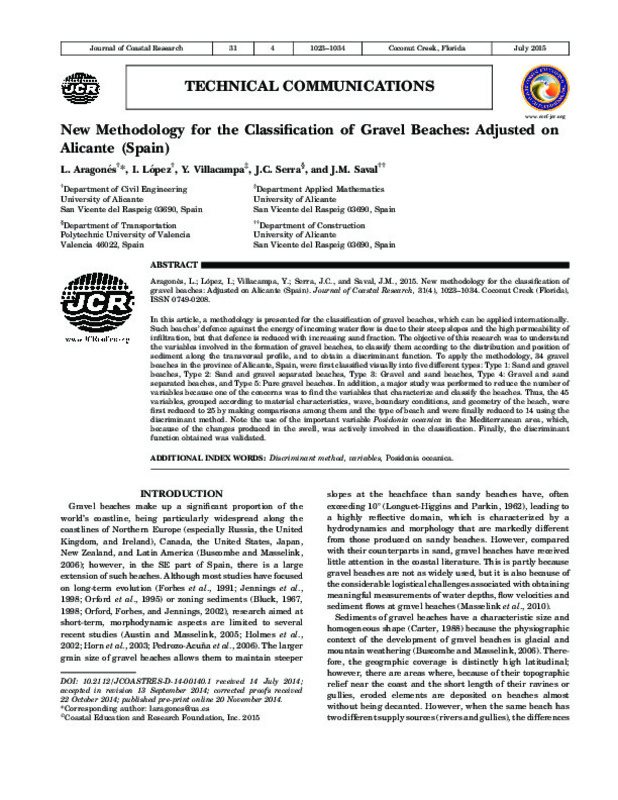JavaScript is disabled for your browser. Some features of this site may not work without it.
Buscar en RiuNet
Listar
Mi cuenta
Estadísticas
Ayuda RiuNet
Admin. UPV
New Methodology for the Classification of Gravel Beaches: Adjusted on Alicante (Spain)
Mostrar el registro sencillo del ítem
Ficheros en el ítem
| dc.contributor.author | Aragones, L.
|
es_ES |
| dc.contributor.author | Lopez, I.
|
es_ES |
| dc.contributor.author | Villacampa, Y.
|
es_ES |
| dc.contributor.author | Serra Peris, José Cristobal
|
es_ES |
| dc.contributor.author | Saval, J.M.
|
es_ES |
| dc.date.accessioned | 2017-12-04T11:05:06Z | |
| dc.date.available | 2017-12-04T11:05:06Z | |
| dc.date.issued | 2018 | es_ES |
| dc.identifier.issn | 0749-0208 | es_ES |
| dc.identifier.uri | http://hdl.handle.net/10251/91922 | |
| dc.description.abstract | [EN] In this article, a methodology is presented for the classification of gravel beaches, which can be applied internationally. Such beaches¿ defence against the energy of incoming water flow is due to their steep slopes and the high permeability of infiltration, but that defence is reduced with increasing sand fraction. The objective of this research was to understand the variables involved in the formation of gravel beaches, to classify them according to the distribution and position of sediment along the transversal profile, and to obtain a discriminant function. To apply the methodology, 34 gravel beaches in the province of Alicante, Spain, were first classified visually into five different types: Type 1: Sand and gravel beaches, Type 2: Sand and gravel separated beaches, Type 3: Gravel and sand beaches, Type 4: Gravel and sand separated beaches, and Type 5: Pure gravel beaches. In addition, a major study was performed to reduce the number of variables because one of the concerns was to find the variables that characterize and classify the beaches. Thus, the 45 variables, grouped according to material characteristics, wave, boundary conditions, and geometry of the beach, were first reduced to 25 by making comparisons among them and the type of beach and were finally reduced to 14 using the discriminant method. Note the use of the important variable Posidonia oceanica in the Mediterranean area, which, because of the changes produced in the swell, was actively involved in the classification. Finally, the discriminant function obtained was validated. | es_ES |
| dc.language | Inglés | es_ES |
| dc.publisher | BioOne (Coastal Education and Research Foundation) | es_ES |
| dc.relation.ispartof | Journal of Coastal Research | es_ES |
| dc.rights | Reserva de todos los derechos | es_ES |
| dc.subject | Discriminant method | es_ES |
| dc.subject | variables | es_ES |
| dc.subject | Posidonia oceanica | es_ES |
| dc.subject.classification | INGENIERIA E INFRAESTRUCTURA DE LOS TRANSPORTES | es_ES |
| dc.title | New Methodology for the Classification of Gravel Beaches: Adjusted on Alicante (Spain) | es_ES |
| dc.type | Artículo | es_ES |
| dc.identifier.doi | 10.2112/JCOASTRES-D-14-00140.1 | es_ES |
| dc.rights.accessRights | Abierto | es_ES |
| dc.contributor.affiliation | Universitat Politècnica de València. Departamento de Ingeniería e Infraestructura de los Transportes - Departament d'Enginyeria i Infraestructura dels Transports | es_ES |
| dc.description.bibliographicCitation | Aragones, L.; Lopez, I.; Villacampa, Y.; Serra Peris, JC.; Saval, J. (2018). New Methodology for the Classification of Gravel Beaches: Adjusted on Alicante (Spain). Journal of Coastal Research. 31(4):1023-1034. doi:10.2112/JCOASTRES-D-14-00140.1 | es_ES |
| dc.description.accrualMethod | S | es_ES |
| dc.relation.publisherversion | https://doi.org/10.2112/JCOASTRES-D-14-00140.1 | es_ES |
| dc.description.upvformatpinicio | 1023 | es_ES |
| dc.description.upvformatpfin | 1034 | es_ES |
| dc.type.version | info:eu-repo/semantics/publishedVersion | es_ES |
| dc.description.volume | 31 | es_ES |
| dc.description.issue | 4 | es_ES |
| dc.relation.pasarela | S\309885 | es_ES |








